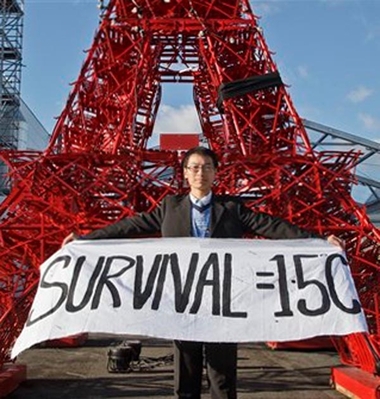Matter of degree: Temperature goal in climate talks an issue

Paris (AP) — Here's a math problem that is confounding international climate negotiators: Which is better, 1.5 or 2 degrees Celsius?
The difference is just half a degree, but small nations say that for them it could mean the difference between life and death. For larger nations, the question is what's realistic and what's not when it comes to limiting global warming.
The broader issue is how much warming is too much. In 2010, international negotiators formally adopted a goal of limiting warming to 2 degrees Celsius (3.6 degrees Fahrenheit) over pre-industrial times; Earth has already warmed nearly 1 degree by now.
The warming goal is what experts call a guardrail, and it has the potential to derail the Paris climate talks if negotiators can't agree on a number.
Small island nations, like Marshall Islands, Tuvalu and St. Lucia, and some other countries are pushing 1.5 because they see that half a degree as an issue of survival. They talk about sea level rise inundating cities, salt water killing off crops, and more dangerous storms wiping out cities. And they have marshalled protesters to join in their effort.
"It's a fight that really should not be focused on numbers 1.5, 2, 2.5," said James Fletcher, St. Lucia's minister for sustainable development, energy, science, and technology. "It should be focused on lives. We're not fighting for numbers, we're fighting for lives."
To climate scientists, who say both numbers are a bit arbitrary, keeping warming to 1.5 degrees could increase the chance of survival of coral reefs, slow the rise in the number of ever-increasing severe weather disasters, and help keep the planet from hitting dreaded but so far unseen tipping points of irreversible environmental damage.
"There is no such thing as a guardrail where we are free from all the impacts of climate change; we've already seen climate change and it's widespread," said Chris Field, a Carnegie Institution scientist who headed an international scientific assessment of climate impacts two years ago.
For some countries, keeping warming to 1.5 degrees may require too steep and painful cuts in carbon dioxide emissions from the burning of coal, oil and gas. But United Nations climate chief Christiana Figueres and climate talks president Laurent Fabius, the French foreign minister, were optimistic about compromise. So far, international negotiators trying to broker a deal say it's a challenge they think they can handle, maybe with some compromise.
"Whether the text will also take into account a very justifiable request from the most vulnerable countries to improve on those efforts, it remains to be seen how that is going to be handled," Figueres said in an interview with The Associated Press. "It wouldn't surprise me if there is a recognition of the intense vulnerability of some nations."
U.S. chief climate negotiator Todd Stern said his delegation has talked with the small islands about their desire for 1.5 goal: "We haven't landed anywhere yet but we hear the concerns of those countries and we think those concerns are legitimate."
Fletcher said he can see a compromise where both goals — 2 and 1.5 — are listed, saying they'll try to hit 1.5 but commit to 2 if they can't.
Then there's the question of whether either goal is attainable.
Andrew Jones, co-director of Climate Interactive, has run the numbers on his computer models that simulate how much the world warms based on how much carbon pollution is spewed.
He calls achieving a 2 degree goal difficult and a 1.5 degree goal "very difficult." His numbers show that current pledges by nations would only limit warming to 3.5 degrees, down from the current trajectory of 4.5 degrees if nations continue producing emissions as they have been.
For example, to do its part in keeping warming to 2 degrees, the U.S. must cut emissions by 4.1 percent a year by 2030, but to get to 1.5, it must cut emissions by 6.2 percent a year. Those cuts would need to increase even more between 2030 and 2050. The fastest a country has ever cut carbon emissions was about 4 percent a year during the 1970s oil crisis, when France switched heavily to nuclear power.
But Jones and MIT professor John Sterman said people shouldn't get bogged down in the numbers right now. They said it's like driving from New York City to San Francisco, arguing about where you are going to park when you get there when you are still only on the East Coast.
For his part, Field it's a bit of academic question, especially since the emissions already spewed stay around for so long the world is nearly already committed to 1.5 degrees of warming.
"We're very, very close," Field said. "We're teetering on the edge of commitment to 1.5 degrees C," Field said. He added that he finds it difficult to imagine how the world can prevent 1.5 degrees of warming "without messing up the global economy, including people in developing countries."
Others, like James Hansen, a former NASA climate chief turned activist, said 2 degrees is too much warming, calling it "a crazy target to have; you cannot say that's a safe guardrail."
Hansen, often considered the godfather of global warming science said "1.5 is certainly less dangerous than 2 degrees; I wouldn't even want to characterize that as a guardrail."
By Seth Borenstein, Angela Charlton and Karl Ritter, Associated Press. Copyright 2015 The Associated Press. All rights reserved. This material may not be published, broadcast, rewritten or redistributed.
The Gayly – December 4, 2015 @ 11 a.m.





